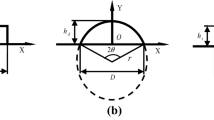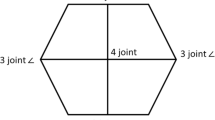Abstract
During the laser cladding process, thermal stresses are induced because of the high-energy input, high temperature gradient, fast cooling rate, and inconsistency of the clad-substrate material. The induced thermal stresses not only increase the crack tendency, but also influence the mechanical performance of the deposited layer. In this study, a three dimensional (3D) uncoupled thermo-mechanical finite element (FE) model was established to simulate the stress evolution of laser cladding of cobalt-based coatings on mild steel A36. The temperature field was simulated first and then used as transient thermal loading to simulate the stress evolution. Stress distributions for three cases: single track on a flat substrate, double-track on a flat substrate, and double-track on a cylindrical substrate, were investigated in detail. To check the accuracy of the simulation results, validation experiments were carried out using an 8-kW high-power direct diode laser. The thermocouples were used to monitor the temperature cycles at several marked points. The cross-sections of single and double tracks on a flat substrate obtained experimentally were compared with the simulation results. The residual stress on the clad was experimentally determined by an X-ray diffraction machine. The experimentally obtained data showed a significant consistency with the prediction results.
Similar content being viewed by others
References
Zhong M, Liu W (2010) Laser surface cladding: the state of the art and challenges. Proc Inst Mech Eng, Part C 224:1041–1060
Zhang Z, Yu T, Kovacevic R (2017) Erosion and corrosion resistance of laser cladded AISI 420 stainless steel reinforced with VC. Appl Surf Sci 410:225–240
Song L, Zeng G, Xiao H, Xiao X, Li S (2016) Repair of 304 stainless steel by laser cladding with 316L stainless steel powders followed by laser surface alloying with WC powders. J Manuf Process 24:116–124
Wang X, Chou K (2017) Electron backscatter diffraction analysis of Inconel 718 parts fabricated by selective laser melting additive manufacturing. JOM 69:402–408
Zhang Z, Kovacevic R (2016) Multiresponse optimization of laser cladding steel+ VC using grey relational analysis in Taguchi Method. JOM 68:1762–1773
Yang G, Liu Z, Wang Y (2013) Influence of molybdenum on the microstructure and mechanical properties of TiC-TiB2 reinforced metal matrix composite coatings. Sci China Technol Sc 56:1008–1016
Wang X, Keya T, Chou K (2016) Build height effect on the Inconel 718 parts fabricated by selective laser melting. Proc Manuf 5:1006–1017
Weng F, Chen C, Yu H (2014) Research status of laser cladding on titanium and its alloys: a review. Mater Des 58:412–425
Luo KY, Jing X, Sheng J, Sun GF, Yan Z, Lu JZ (2016) Characterization and analyses on micro-hardness, residual stress and microstructure in laser cladding coating of 316L stainless steel subjected to massive LSP treatment. J Alloy Compd 673:158–169
X. Wang, K. Chou, A method to estimate residual stress in metal parts made by Selective Laser Melting. Proc. ASME 2015 Int. Mech. Eng. Congr. Expo. Am. Soc. Mech. Eng. 2015, p. V02AT02A002
Yan Z, Liu W, Tang Z, Liu X, Zhang N, Li M, Zhang H (2018) Review on thermal analysis in laser-based additive manufacturing. Opt Laser Technol 106:427–441
Nazemi N, Urbanic RJ (2018) A numerical investigation for alternative toolpath deposition solutions for surface cladding of stainless steel P420 powder on AISI 1018 steel substrate. Int J Adv Manuf Tech 96:4123–4143
Heigel JC, Michaleris P, Reutzel EW (2015) Thermo-mechanical model development and validation of directed energy deposition additive manufacturing of Ti–6Al–4V. Addit. Manuf. 5:9–19
Jendrzejewski R, Śliwiński G, Krawczuk M, Ostachowicz W (2004) Temperature and stress fields induced during laser cladding. Comput Struct 82:653–658
Suarez A, Amado JM, Tobar MJ, Yáñez A, Fraga E, Peel MJ (2010) Study of residual stresses generated inside laser cladded plates using FEM and diffraction of synchrotron radiation. Surf. Coat. Tech. 204:1983–1988
P. Farahmand, R. Kovacevic, R, An experimental–numerical investigation of heat distribution and stress field in single-and multi-track laser cladding by a high-power direct diode laser, Opt Laser Technol 63 (2014) 154–168
Chew Y, Pang JHL, Bi G, Song B (2015) Thermo-mechanical model for simulating laser cladding induced residual stresses with single and multiple clad beads. J. Mater. Process Tech. 224:89–101
Bailey NS, Katinas C, Shin YC (2017) Laser direct deposition of AISI H13 tool steel powder with numerical modeling of solid phase transformation, hardness, and residual stresses. J. Mater. Process Tech. 247:223–233
Jeshvaghani RA, Shamanian M, Jaberzadeh M (2011) Enhancement of wear resistance of ductile iron surface alloyed by stellite 6. Mater Des 32:2028–2033
Singh R, Kumar D, Mishra SK, Tiwari SK (2014) Laser cladding of Stellite 6 on stainless steel to enhance solid particle erosion and cavitation resistance. Surf. Coat. Tech. 251:87–97
Zhang Z, Farahmand P, Kovacevic R (2016) Laser cladding of 420 stainless steel with molybdenum on mild steel A36 by a high power direct diode laser. Mater Des 109:686–699
Mohammadpour M, Yazdian N, Yang G, Wang H P, Carlson B, Kovacevic R (2018). Effect of dual laser beam on dissimilar welding-brazing of aluminum to galvanized steel. Opt Laser Technol 98: 214–228
Liu J, Wang Y, Li H, Costil S, Bolot R (2017) Numerical and experimental analysis of thermal and mechanical behavior of NiCrBSi coatings during the plasma spray process. J. Mater. Process Tech. 249:471–478
Nadimi S, Khoushehmehr RJ, Rohani B, Mostafapour A (2008) Investigation and analysis of weld induced residual stresses in two dissimilar pipes by finite element modeling. J Appl Sci 8:1014–1020
Zhang J, Liou F, Seufzer W, Taminger K (2016) A coupled finite element cellular automaton model to predict thermal history and grain morphology of Ti-6Al-4V during direct metal deposition (DMD). Addit Manuf 11:32–39
Hofman JT, De Lange DF, Pathiraj B, Meijer J (2011) FEM modeling and experimental verification for dilution control in laser cladding. J Mater Process Tech 211:187–196
Knapp GL, Mukherjee T, Zuback JS, Wei HL, Palmer TA, De A, DebRoy T (2017) Building blocks for a digital twin of additive manufacturing. Acta Mater 135:390–399
Zhang CS, Li L, Deceuster A (2011) Thermomechanical analysis of multi-bead pulsed laser powder deposition of a nickel-based superalloy. J Mater Process Technol 211:1478–1487
Wang F, Mao H, Zhang D, Zhao X, Shen Y (2008) Online study of cracks during laser cladding process based on acoustic emission technique and finite element analysis. Appl Surf Sci 255:3267–3275
Farahmand P, Liu S, Zhang Z, Kovacevic R (2014) Laser cladding assisted by induction heating of Ni–WC composite enhanced by nano-WC and La2O3. Ceram Int 40 (15421–15438
Fallah V, Alimardani M, Corbin SF, Khajepour A (2010) Impact of localized surface preheating on the microstructure and crack formation in laser direct deposition of Stellite 1 on AISI 4340 steel. Appl Surf Sci 257:1716–1723
Wang D, Hu Q, Zeng X (2015) Residual stress and cracking behaviors of Cr13Ni5Si2 based composite coatings prepared by laser-induction hybrid cladding. Surf Coat Tech 274:51–59
Acknowledgements
The authors would like to thank Andrew Socha, a research engineer at the Research Center for Advanced Manufacturing, for his help in the execution of experiments. The first author, Zhe Zhang, would like to thank Dr. Lin Zhu, a former Ph.D. candidate at the Department of Mechanical Engineering, Southern Methodist University, for his support and encouragement during the preparation of this work.
Funding
This work was financially supported by the NSF’s Grant No. IIP-1539853.
Author information
Authors and Affiliations
Corresponding author
Rights and permissions
About this article
Cite this article
Zhang, Z., Kovacevic, R. A thermo-mechanical model for simulating the temperature and stress distribution during laser cladding process. Int J Adv Manuf Technol 102, 457–472 (2019). https://doi.org/10.1007/s00170-018-3127-y
Received:
Accepted:
Published:
Issue Date:
DOI: https://doi.org/10.1007/s00170-018-3127-y




